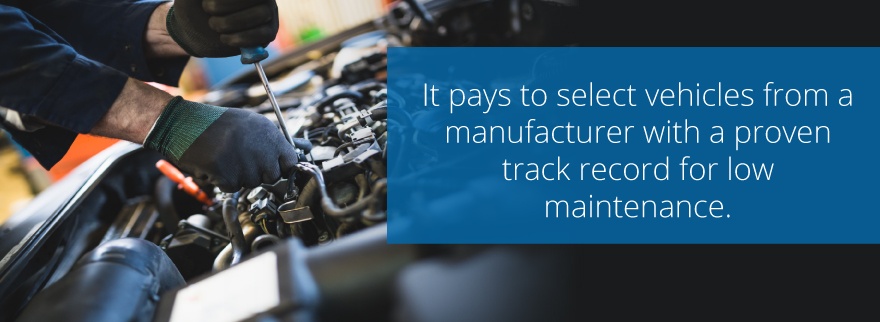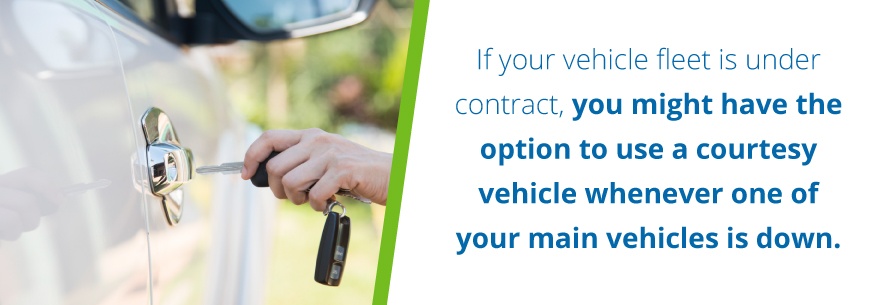

For anyone who operates a fleet, vehicle downtime is one of the most troubling aspects of the business. When a vehicle is down for any reason, productivity is lost at some level. Whether the vehicle in question is the main vehicle of a small operation or one of many similar vehicles in a large fleet, the inactivity of said vehicle will correlate to a dip in productivity and profit.
Due to the numerous factors at stake, the goal of reducing fleet vehicle downtime is a critical aim for any commercial trucking operation. The following article details 12 unique ways to keep vehicle fleet downtime to a minimum.

Check out these 12 tips for reducing fleet vehicle downtime. Click on a link in the outline below to jump to that section in the content.
To keep fleet vehicle downtime to an absolute minimum, ensure that all vehicles receive maintenance on a regular basis. This way, your company will be aware of any performance issues before they begin. With regular servicing and maintenance, you will also reduce the frequency of downtime and costly repairs that could otherwise arise during a given route. Simply put, regular maintenance is a key component of fleet management that helps carriers cut expenditures, boost profits, and maximize efficiency.
To ensure that fleet inspections and service operations are carried out on a consistent basis, you must maintain tight communication with your maintenance provider. It is crucial for the maintenance crew to understand the needs of your fleet and to carry out inspections accordingly. While it might not be possible to prevent problems in all cases, you can reduce fleet downtime drastically with this proactive approach to maintenance.
Another way to reduce fleet vehicle downtime is to purchase new vehicles with greater frequency. While the practice might seem costlier on paper, you can actually save money by purchasing vehicles more often. For starters, newer vehicles are equipped with the latest automotive technology and therefore have more robust mechanisms. You can often buy newer vehicles with warranties lasting three years or more, and you can exercise this option for free repairs or replacements if issues ever arise.
With older vehicles, performance issues are inevitable. The longer you use a truck, the likelier you will need to invest in costly maintenance and repair work, especially as tens of thousands of miles add up on the meter. Even the trucks that provide years of reliable service are bound to be a financial liabilities sooner or later. When you continually bring newer vehicles into the fleet, you can slowly phase out older, more troubled vehicles and keep downtime and performance issues to a minimum.
Frequencies of vehicle fleet downtime are generally lower among fleets that choose the right vehicles. As such, it pays to select vehicles from a manufacturer with a proven track record for low maintenance.

Granted, your options might be limited if you operate within a select niche of the carrying sector. If you require vehicles with complex parts for special operations, there will inevitably be more components that could break down at some point. Still, it is generally wise to research vehicle manufacturers and know which truck makers produce vehicles with the lowest frequency of issues.
These days, insurance companies are more forthcoming about which vehicle brands are more costly or less expensive to repair. As a general rule, the trucks that are most common are less expensive to repair because the replacement parts for such vehicles are more widely available on the aftermarket.
Aside from the costs involved with maintenance and repair, two of the costliest issues among fleets are accidents and excess fuel consumption, both of which are largely due to speeding. One of the most effective ways to prevent drivers from speeding is to equip each vehicle with a speed-limiting device, which restricts the maximum speed of the vehicle to the legal national limit.
Speed limits and fleet rules aside, some drivers are liable to drive faster than they should to beat the clock and fulfill more deliveries within a given timeframe. Consequently, the adoption of speed limiters might be met with resistance among some drivers, who might see the move as another form of outside control. Nonetheless, speed limiters help fleets reduce fuel consumption on an annual basis and lower the risk of accidents along the overall routing grid.
In some operations, it simply does not pay to have an entire fleet on hand throughout the year. If your intensive periods are seasonal, such as during winter months, what use would the extra vehicles serve from spring through fall? For operations of this magnitude, it could be more economical to maintain a smaller fleet through most of the year and get contract vehicles during high season.
Depending on the type of industry you serve and the vehicles in question, the contract approach might not be an option. The terms of such agreements might also be unfavorable and effectively cancel out the benefits. If possible, however, you could reduce the costs of vehicle maintenance that you would otherwise incur throughout the year. The contract option could also help you reduce the need for newer vehicles since fewer will be required for your basic operations.
Despite your efforts to keep your vehicles operable at all times, certain vehicles will need to be sidelined from time to time. However, when a vehicle is off for repairs, you can still avoid downtime. If your vehicle fleet is under contract, you might have the option to use a courtesy vehicle whenever one of your main vehicles is down.

Whenever one of your main carrying trucks is out for service, a courtesy vehicle could help you fulfill deliveries as normal. Under certain flexible hire packages, you can access a courtesy vehicle whenever a fleet truck is undergoing engine or body repairs.
Courtesy vehicles may not be an option for all fleets or vehicle types. If you own your fleet free and clear, you might not be able to call upon courtesy vehicles. To learn whether or not you qualify, ask your fleet management provider about courtesy options.
One way to offset the losses of fleet downtime is to operate during regular as well as graveyard hours. This way, your fleet will accomplish twice as many deliveries in the space of a given week. Though this won’t, in and of itself, prevent vehicle downtime, it will help you achieve double the work per service cycle.
Of course, a range of other issues could arise with double shifts. Not all drivers would be happy to work such hours, as some have other obligations or simply prefer to work only in the daytime. Those who would agree to drive between 10 p.m. and 5 a.m. would likely demand higher pay for shifts during those hours.
As for the service life of a given vehicle, double-shifts have advantages and disadvantages. On the downside, vehicles are put to use more frequently and incur more wear and tear when driven both day and night. On the upside, delivery routes tend to be less busy after dark, which means less stop-and-go traffic and fewer potential conflicts with fellow motorists during night-time hours.
Enter your contact details, we’ll get in touch, keep your fleet running!
One seemingly redundant yet effective method for reducing fleet vehicle downtime is to have each driver recurrently undergo training. Despite the fact that most drivers will have already had years of experience on the road, the best professionals in all fields retrain from time to time. The purpose is for drivers to gain new insights into safe driving practices and curb bad habits that they may have developed over the years.
After a brief period of retraining, a driver could possibly identify and eradicate habits that are detrimental to a vehicle, such as shifting gears with too much suddenness or force. If a driver tends to turn abruptly or switch lanes too aggressively, a bit of training could bring these habits to their attention. Once eradicated, the driver will be safer on the road and put less strain on the vehicle.
Driver training can also help drivers improve their vehicle-inspection skills. For example, a training program could include a portion that describes the things to look for on a vehicle while carrying out an inspection. How can you identify bad tires, wheels or engine parts with the naked eye? What types of engine sounds serve as indicators of looming problems? Armed with this knowledge, drivers could help keep the vehicles better maintained.
Within a given fleet, certain problems are bound to reoccur due to oversights or human error. In some cases, the problem might be down to the bad habits of a particular driver. To pinpoint and rectify these issues, you might consider using a data-gathering and analysis system.
Fleet data analysis could let you know if you have been overlooking recurring fleet downtime somewhere, or if certain individuals have been involved in multiple accidents or hastened the wear on certain vehicles.
If your fleet has practiced sub-standard maintenance, data analysis could make this information more readily available than before. If a driver has a poor track record for road safety, such data could help you determine whether it would be best to retrain or simply terminate the individual.
Data analysis can also shine a light on discrepancies in fuel consumption and fuel-related downtime. For example, if certain vehicles have consumed disproportionate amounts of fuel for the routes in question, the problem can more readily be identified and rectified with data analysis. Fuel-tracking technology like FUELChex from Shipley Energy makes it possible to manage issues related to fuel efficiency.
Fleet downtime can actually be turned to your advantage if you can plan such occurrences in advance. The objective here is to make use of those times when the vehicle would not be running anyway. On days when the driver is on vacation or temporarily sidelined, use this time as an opportunity to inspect the vehicle and perform any maintenance that might be necessary. If there are days of the month when a certain vehicle will not be used for deliveries, set these times aside for inspections and possible maintenance.
Another way to enact a useful downtime strategy is to forecast such days on a monthly or seasonal basis. For example, vehicle A could be submitted for maintenance on the first Friday of every month, while vehicles B, C and D could each be set aside for inspections and maintenance on the second, third and fourth Fridays, respectively.
On those occasions when a vehicle gets sidelined due to some unexpected mishap, use this as an opportunity to rectify more than just the problem in question. For example, if the clutch fails or a fluid compartment leaks, have the maintenance workers inspect the entire vehicle for other possible problems. In addition to the new clutch or tank, you might be alerted to looming issues with other parts of the vehicle and have those problems solved in advance.
Basically, this method allows you to consolidate downtime by solving two or more issues in a single day that might otherwise occur on separate days over a six-month period.
The time it takes to fuel a vehicle could be time off the road during a given route. When added up over the course of a typical year, daytime vehicle fueling could amount to many days of downtime. Why take time out to fuel up during the day when your vehicles could easily be fueled during off-hours when the drivers are asleep?
When you hire a mobile fleet-fueling service like Shipley Energy, your entire fleet will be fueled during hours when the vehicles are otherwise not in use. Whether the vehicle requires gas or diesel fuel, refueling can be done after-hours. Even if you operate longer shifts and certain vehicles are in use until 10 p.m. each night, a 24-hour fleet service will come and refuel your fleet between 12 a.m. and 5 a.m. if necessary. This way, drivers will not have to take time out from their busy schedules to refuel vehicles and squander productivity.
Vehicle fleet downtime is the bane of any business that operates hauling trucks, rolling stock or any other type of commercial vehicle. Whether the issue stems from fuel inefficiency, poor driving habits or issues with engine or underside components, fleets lose money each time a vehicle goes down.
At Shipley Energy, we provide services that keep commercial vehicles up and running throughout the course of daily and nightly working schedules. From our cardlock fueling stations to our FUELChex logistics service, vehicles are in good hands with our help. Explore our site more to learn other ways Shipley Energy can lower your downtime today, or contact us with any questions you might have.

Shipley is a very important part of making Dottie’s a success. They provide us with Non Ethanol 87,90,93 grade fuel which is a huge draw for our loyal non ethanol customers. Shipley also provides us with Kerosene, Off Road, and On Road Diesel at competitive prices a...
Read moreShipley is a very important part of making Dottie’s a success. They provide us with Non Ethanol 87,90,93 grade fuel which is a huge draw for our loyal non ethanol customers. Shipley also provides us with Kerosene, Off Road, and On Road Diesel at competitive prices and a timely manner. Shipley helps us most by managing our delivery, watching the market, and deciding when the best time to purchase a load would be to capture the most savings. This is particularly important in these volatile times in which we are working.
Read less